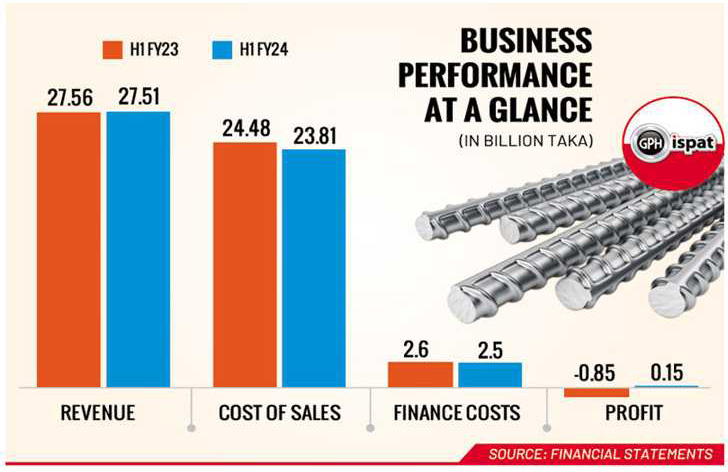
GPH Ispat on path of recovery from Q2 as raw materials get cheaper
FE REPORT | Friday, 2 February 2024
GPH Ispat returned to profit in the second quarter through December 2023 from losses in the same quarter a year before, supported by higher sales coupled with falling raw materials prices in the global market.
The steel maker also reaped the benefit of an increase in product prices and a reduction in selling & distribution expenses. The outcome was a gain of Tk 318 million in Q2, FY24 as opposed to a loss of Tk 56 million in the same quarter of the previous fiscal year.
The company managed to cut selling & distribution expenses by 31 per cent year-on-year to Tk 225 million in the October-December quarter. On the other hand, revenue was up 14 per cent year-on-year to Tk 16.56 billion in the quarter to December last year, according to unaudited financial statements published on Thursday.

However, GPH Ispat's half-yearly profit fell to Tk 154 million for the six months through December 2023 since its first quarter loss wiped out part of the profit made in the second quarter. Still, the business did better in the first half of FY24, compared to the same period of FY23 when it experienced a loss of Tk 850 million.
The net revenue was almost the same for the six months through December of FY23 and FY24.
Apart from domestic sales, the company exports billet to China. Export grew 224 per cent year-on-year to Tk 159 million in July-December last year, according to unaudited financial statements.
The cost of sales, which includes all associated costs to produce products, stood at Tk 23.81 billion, which was 86 per cent of the total revenue in July-December 2023, down from 89 per cent of the revenue in the same period of the previous year.
Company secretary Md Mosharof Hossain said GPH Ispat had successfully managed to rein in operating costs while taking advantage of cheaper raw materials.
Costs of borrowing increased but foreign currency transaction losses came down, driving the company's finance expenses 4 per cent lower year-on-year to Tk 2.50 billion in the six months to December last year.
Following the earnings disclosure, the stock of GPH Ispat soared 7.55 per cent to Tk 34.2 per share on Thursday from the day before. After remaining stuck on the floor for 16 months, the stock plunged more than 23 per cent since the withdrawal of the price restriction about two weeks ago.
The company's long-term and short-term debt burden remained almost the same at Tk 22.06 billion and Tk 30 billion respectively as of December last year.
GPH Ispat, listed on the bourses in 2012, booked losses for the first time in the first quarter (Q1) of FY23. Negative income extended to Q2 in FY23, owing to a sharp depreciation of the local currency against the dollar.
As a result, its annual profit slid 82 per cent to Tk 268 million in FY23.
A significant increase in foreign currency conversion rate, higher prices of raw materials, and power supply disruption pushed up the production costs in FY23.
Industry insiders say that although the raw materials' prices have been cooling off in the global market in recent months from a record high, most steel manufacturers could not reap benefit for failing to open letters of credit due to the dollar shortage.
The crisis has been intensified by frequent power outages caused by gas supply shortage. On top of that, the taka continued to lose value against the dollar, causing steel manufacturers to bleed.
GPH Ispat is engaged in manufacturing and trading MS Billet and MS Rod. The company features a state-of-the-art laboratory to ensure the highest quality of finished products.
In June 2021, GPH Ispat started commercial production at its new plant built using quantum technology - the first in Asia and the second in the world - at a cost of Tk 25 billion, according to the company.
The company claimed that it began commercial production of the world's best "GPH Quantum" steel.
[email protected]